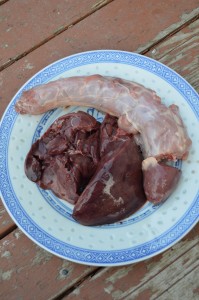 This was the first year that I had a hand in preparing the Thanksgiving turkey. Subsequently it was also the first time that I came in contact with the infamous giblets: the neck, heart, liver, and gizzard of the turkey, stored together in a bag in the cavity of the bird.
This was the first year that I had a hand in preparing the Thanksgiving turkey. Subsequently it was also the first time that I came in contact with the infamous giblets: the neck, heart, liver, and gizzard of the turkey, stored together in a bag in the cavity of the bird.
First things first: I needed to know what I was dealing with. I was familiar with the general shape and function of the first three items on that list. The gizzard, however, I embarrassingly thought was the flap of skin hanging between a turkey’s beak and neck. Turns out this is the wattle, “an organ of sexual dimorphism” (Wikipedia), whatever that means. The gizzard is actually a stomach with strong muscles that break down food.
On inspection of my own turkey giblets, and comparison with pictures on the internet, I decided that I was not given a gizzard, and that my turkey’s liver had been broken in two. In the picture at left, clockwise from the top left is the neck (obviously), the heart, and two pieces of liver.
A quick Google search suggested that the giblets are most often simmered with the gravy to add extra offally good (pun) flavour. I also looked for preparations dealing just with the liver. People online were divided as to whether turkey livers make for good eats. You can only read so many blogs and forums that waffle back and forth before just trying it out yourself.
I basically followed Julia Childs’ recipe for sautéed chicken livers: salt, pepper, and flour the livers, then sauté them in butter and oil with mushrooms and ham (homemade bacon in my case). I spread the mixture on lightly toasted baguette rounds, then had them as an appetizer to left-over turkey and mashed potatoes.
The neck and heart are great additions to turkey stock.
